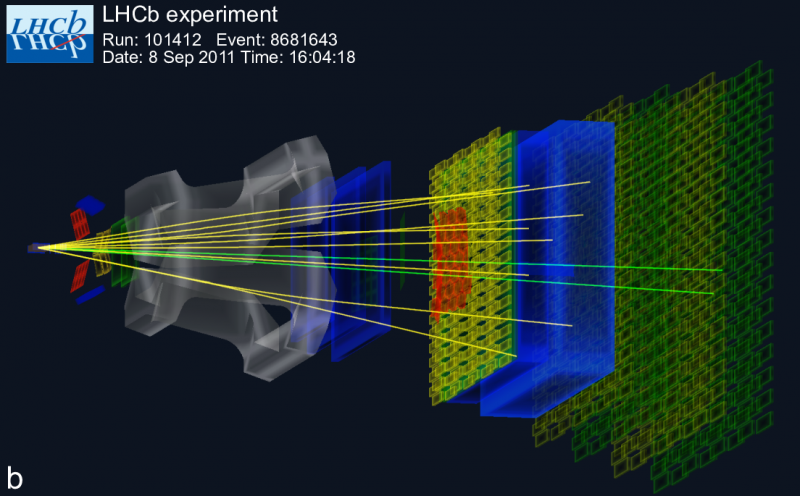In this event display from the LHCb experiment at CERN's Large Hadron Collider, proton-proton collisions at the interaction point (far left) result in a shower of leptons and other charged particles. The yellow and green lines are computer-generated reconstructions of the particles' trajectories through the layers of the LHCb detector. Credit: CERN/LHCb Collaboration
(Phys.org)—It has been another good week for physics as a team working at the CERN complex found evidence that suggests subatomic particles could defy the standard model—they found tau leptons and muons decaying at different rates. Also, another team at the Australian National University announced a new theory that could lead to a radiationless revolution—it describes a way to confine electromagnetic energy without leakage. And Matthew Fisher with the University of California proposed the idea of quantum cognition based on synaptic nuclear spins, i.e. neural qubits. His idea is that quantum processing with nuclear spins might be happening in the brain. Also, a company called Tri Alpha Energy reportedly made an important breakthrough in developing a fusion reactor—they found a way to hold a ball of superheated hydrogen plasma for five milliseconds.
The news from space was good as well, as NASA announced that the New Horizons mission exceeded expectations—sending back images of Pluto and its moons along with a host of other valuable scientific data. Also, another team of astrophysicists found supermassive black holes in the quasar nearest Earth—within Galaxy Markarian 231, they discovered has two black holes spinning around each other.
In other news, researchers working at Los Alamos National Laboratory announced that they had created quantum dot solar windows that go non-toxic and colorless, all with record efficiency—the windows capture some of the light that passes through the glass and divert it to solar cells at the edges. And a team of researchers at the University of Toronto announced that they had developed a new "tissue Velcro" that could help repair damaged hearts—it is a scaffolding upon which new heart muscle can grow. Also, another team working at MIT created a new printer called "Multifab" that 3D-prints a record 10 materials at once with no assembly required. It has a resolution of 40 microns and is the first 3D printer to use 3D scanning techniques from machine vision.
And finally, if you have ever been accused of being neurotic, a small team of psychologists with King's College in London and Columbia University in the U.S. asked the question: Is neuroticism fueled by overthinking? And they think they have found why creativity and neurosis-related unhappiness and go hand-in-hand—the same parts of the brain appear to be involved in both.
© 2015 Phys.org
























